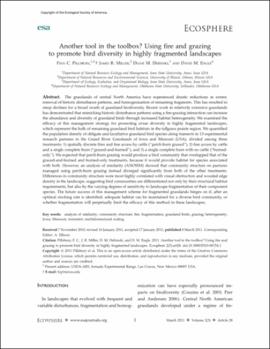| dc.contributor.author | Pillsbury, Finn C. | |
| dc.contributor.author | Miller, James R. | |
| dc.contributor.author | Debinski, Diane M. | |
| dc.contributor.author | Engle, David M. | |
| dc.date.accessioned | 2019-08-22T17:50:56Z | |
| dc.date.available | 2019-08-22T17:50:56Z | |
| dc.date.issued | 2011-03-08 | |
| dc.identifier | oksd_pillsbury_anothertoolinth_2011 | |
| dc.identifier.citation | Pillsbury, F. C., Miller, J. R., Debinski, D. M., & Engle, D. M. (2011). Another tool in the toolbox? Using fire and grazing to promote bird diversity in highly fragmented landscapes. Ecosphere, 2(3). https://doi.org/10.1890/ES10-00154.1 | |
| dc.identifier.uri | https://hdl.handle.net/11244/321248 | |
| dc.description.abstract | The grasslands of central North America have experienced drastic reductions in extent, removal of historic disturbance patterns, and homogenization of remaining fragments. This has resulted in steep declines for a broad swath of grassland biodiversity. Recent work in relatively extensive grasslands has demonstrated that mimicking historic disturbance patterns using a fire‐grazing interaction can increase the abundance and diversity of grassland birds through increased habitat heterogeneity. We examined the efficacy of this management strategy for promoting avian diversity in highly fragmented landscapes, which represent the bulk of remaining grassland bird habitats in the tallgrass prairie region. We quantified the population density of obligate and facultative grassland bird species along transects in 13 experimental research pastures in the Grand River Grasslands of Iowa and Missouri (USA), divided among three treatments: 1) spatially discrete fires and free access by cattle (“patch‐burn grazed”), 2) free access by cattle and a single complete burn (“grazed‐and‐burned”), and 3) a single complete burn with no cattle (“burned‐only”). We expected that patch‐burn grazing would produce a bird community that overlapped that of the grazed‐and‐burned and burned‐only treatments, because it would provide habitat for species associated with both. However, an analysis of similarity (ANOSIM) showed that community structure on pastures managed using patch‐burn grazing instead diverged significantly from both of the other treatments. Differences in community structure were most highly correlated with visual obstruction and wooded edge density in the landscape, suggesting bird communities are differentiated not only by their structural habitat requirements, but also by the varying degrees of sensitivity to landscape fragmentation of their component species. The future success of this management scheme for fragmented grasslands hinges on if, after an optimal stocking rate is identified, adequate habitat can be maintained for a diverse bird community, or whether fragmentation will perpetually limit the efficacy of this method in these landscapes. | |
| dc.format | application/pdf | |
| dc.language | en_US | |
| dc.publisher | Ecological Society of America | |
| dc.rights | This material has been previously published. In the Oklahoma State University Library's institutional repository this version is made available through the open access principles and the terms of agreement/consent between the author(s) and the publisher. The permission policy on the use, reproduction or distribution of the material falls under fair use for educational, scholarship, and research purposes. Contact Digital Resources and Discovery Services at lib-dls@okstate.edu or 405-744-9161 for further information. | |
| dc.title | Another tool in the toolbox? Using fire and grazing to promote bird diversity in highly fragmented landscapes | |
| osu.filename | oksd_pillsbury_anothertoolinth_2011.pdf | |
| dc.description.peerreview | Peer reviewed | |
| dc.identifier.doi | 10.1890/ES10-00154.1 | |
| dc.description.department | Natural Resource Ecology and Management | |
| dc.type.genre | Article | |
| dc.type.material | Text | |
| dc.subject.keywords | analysis of similarity | |
| dc.subject.keywords | community structure | |
| dc.subject.keywords | fire | |
| dc.subject.keywords | fragmentation | |
| dc.subject.keywords | grassland birds | |
| dc.subject.keywords | grazing | |
| dc.subject.keywords | heterogeneity | |
| dc.subject.keywords | iowa | |
| dc.subject.keywords | missouri | |
| dc.subject.keywords | nonmetric multidimensional scaling | |
